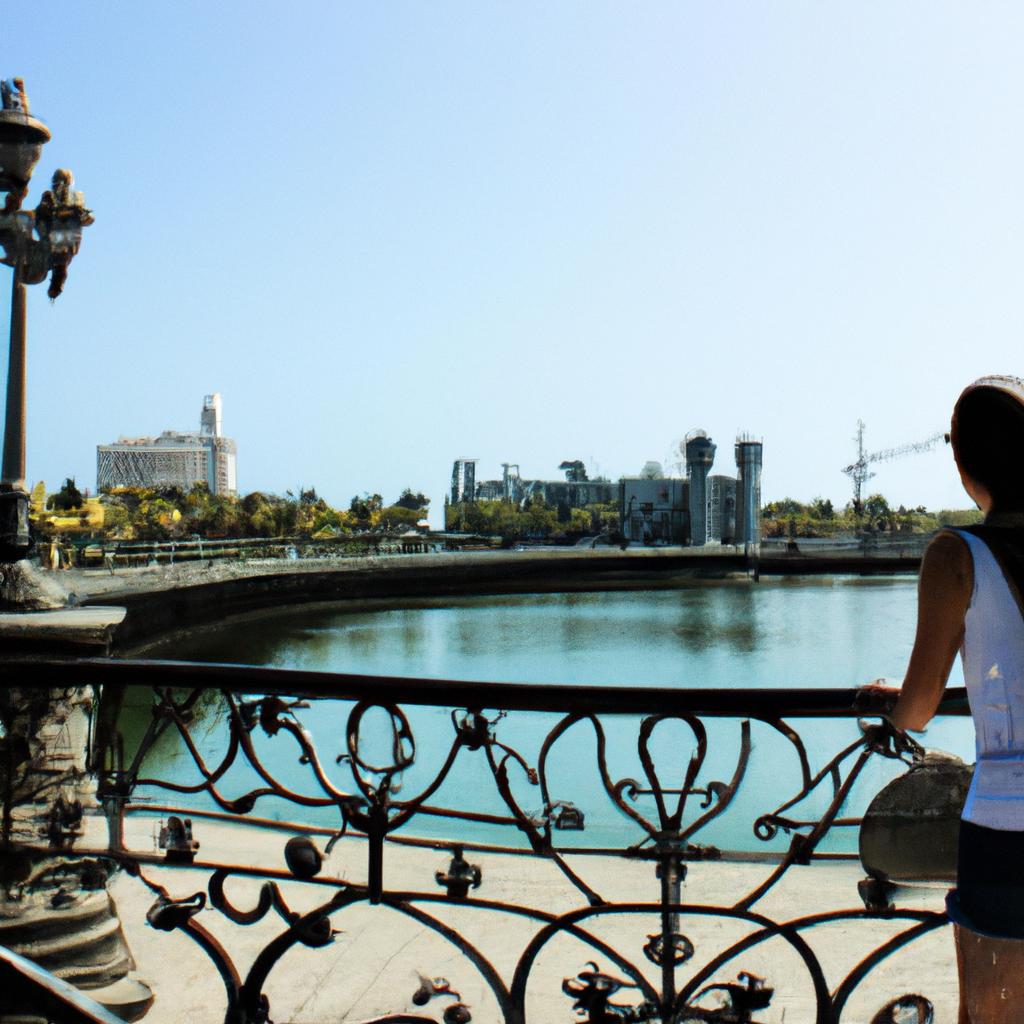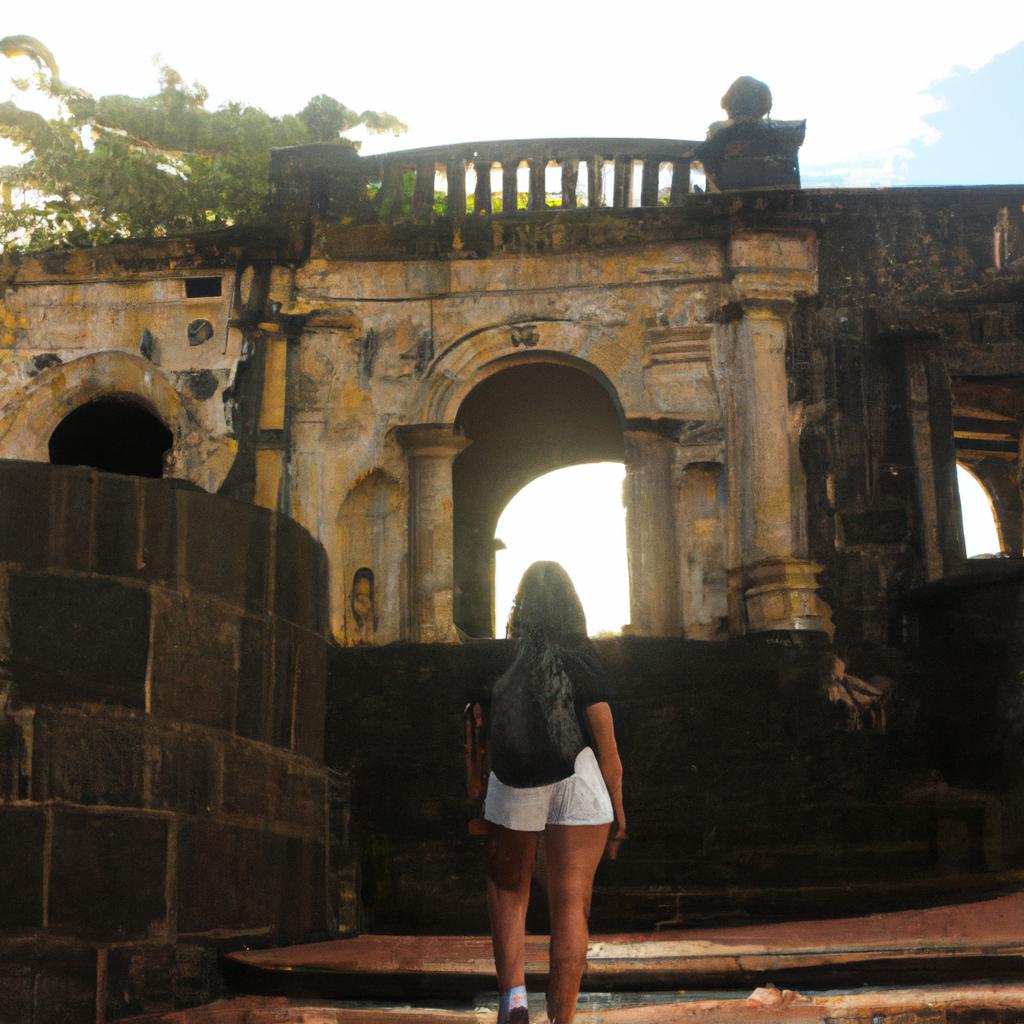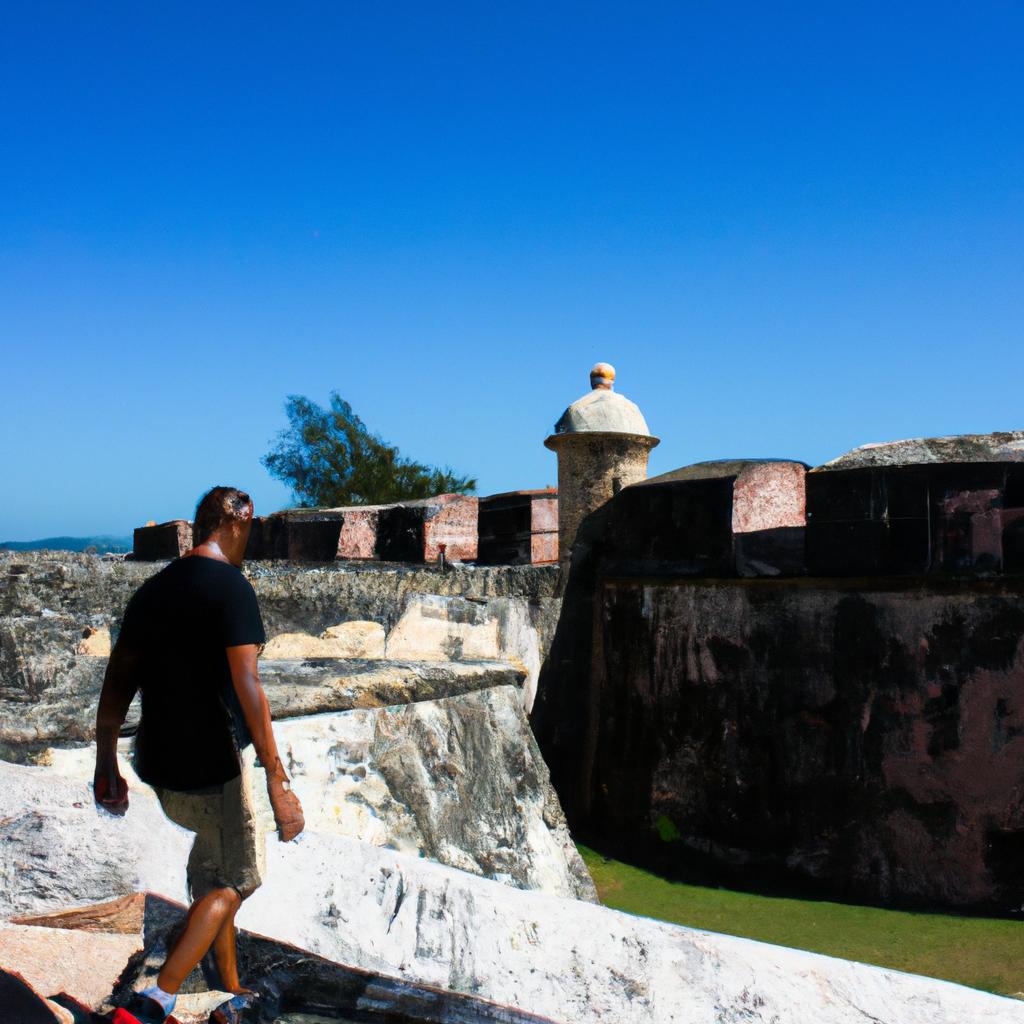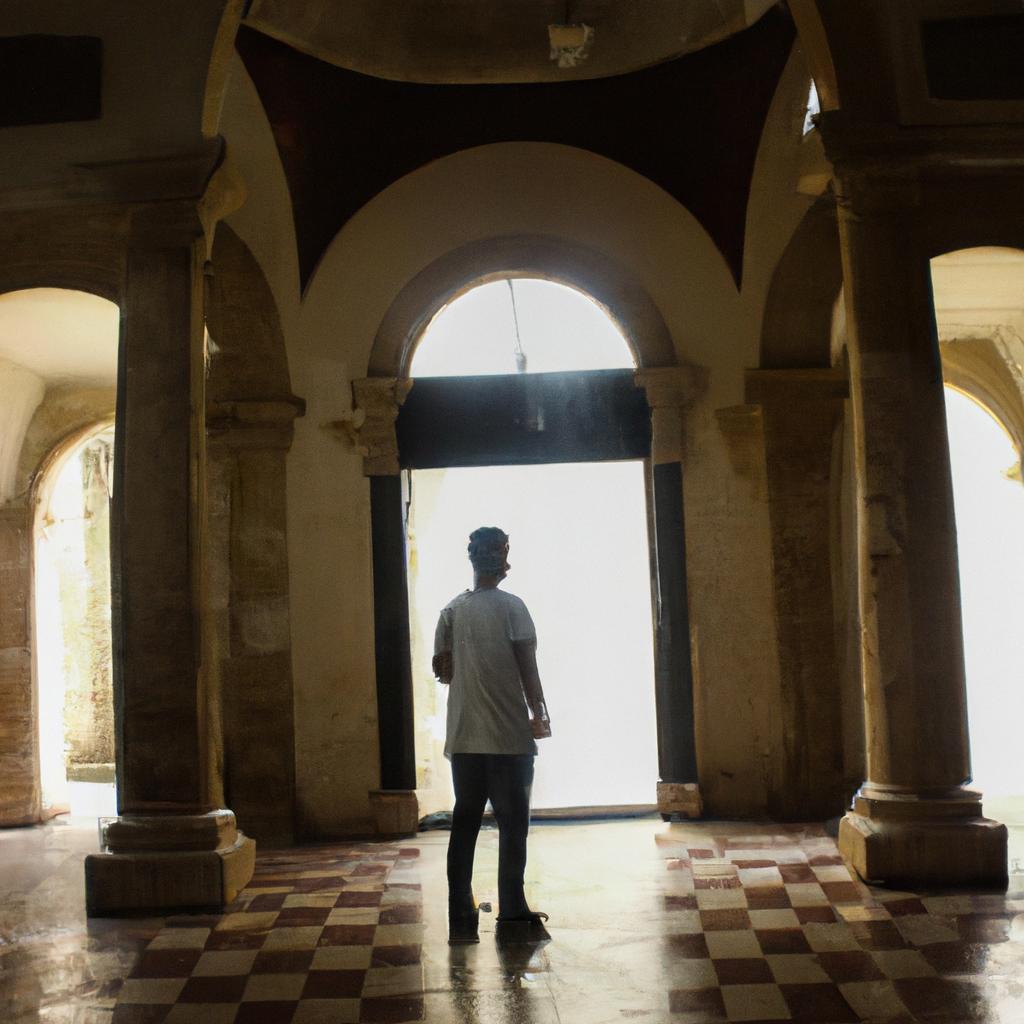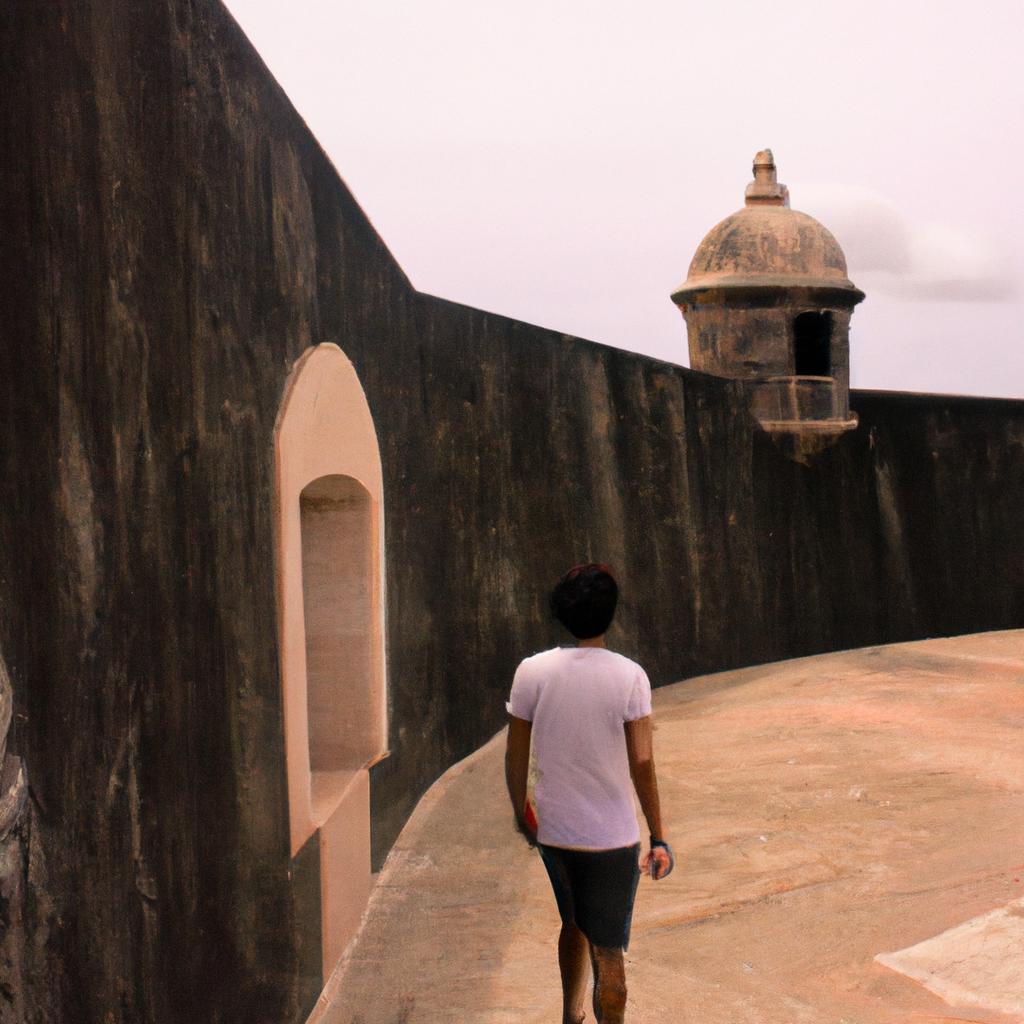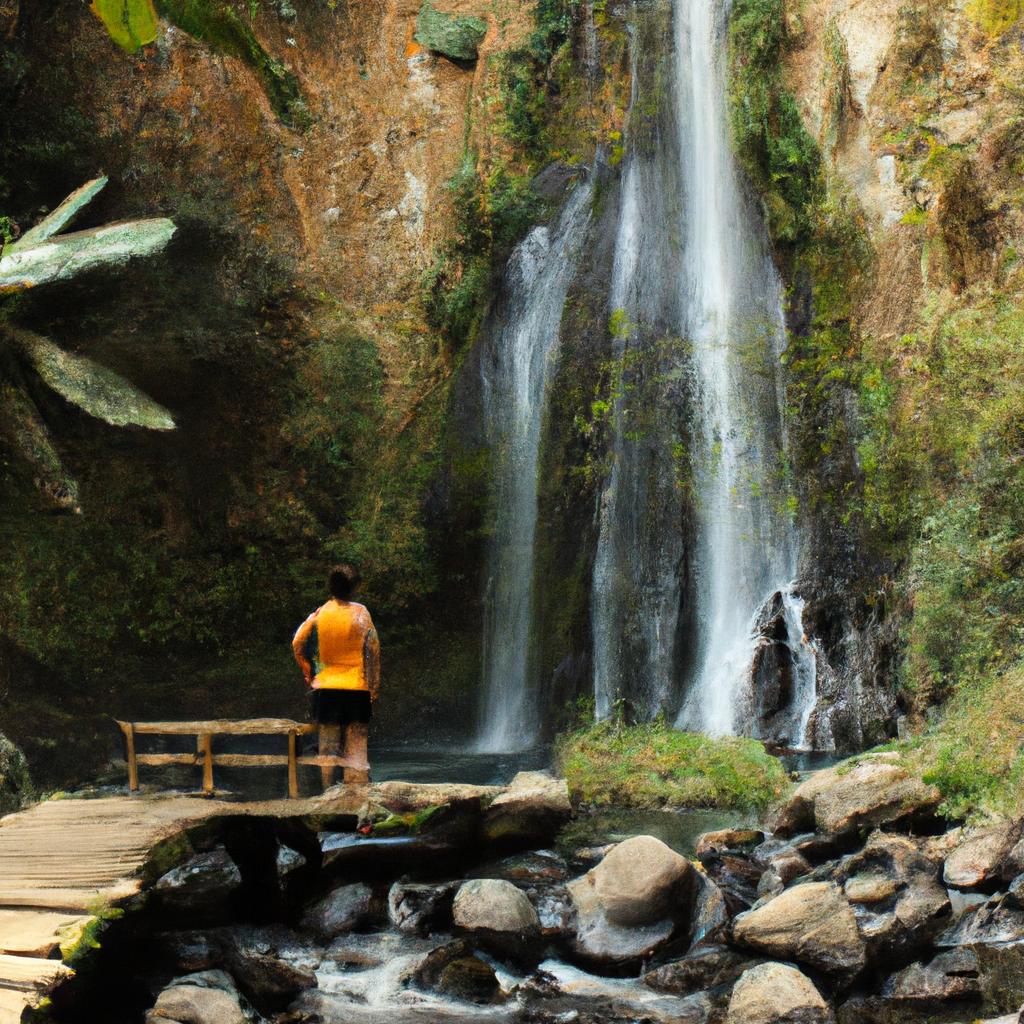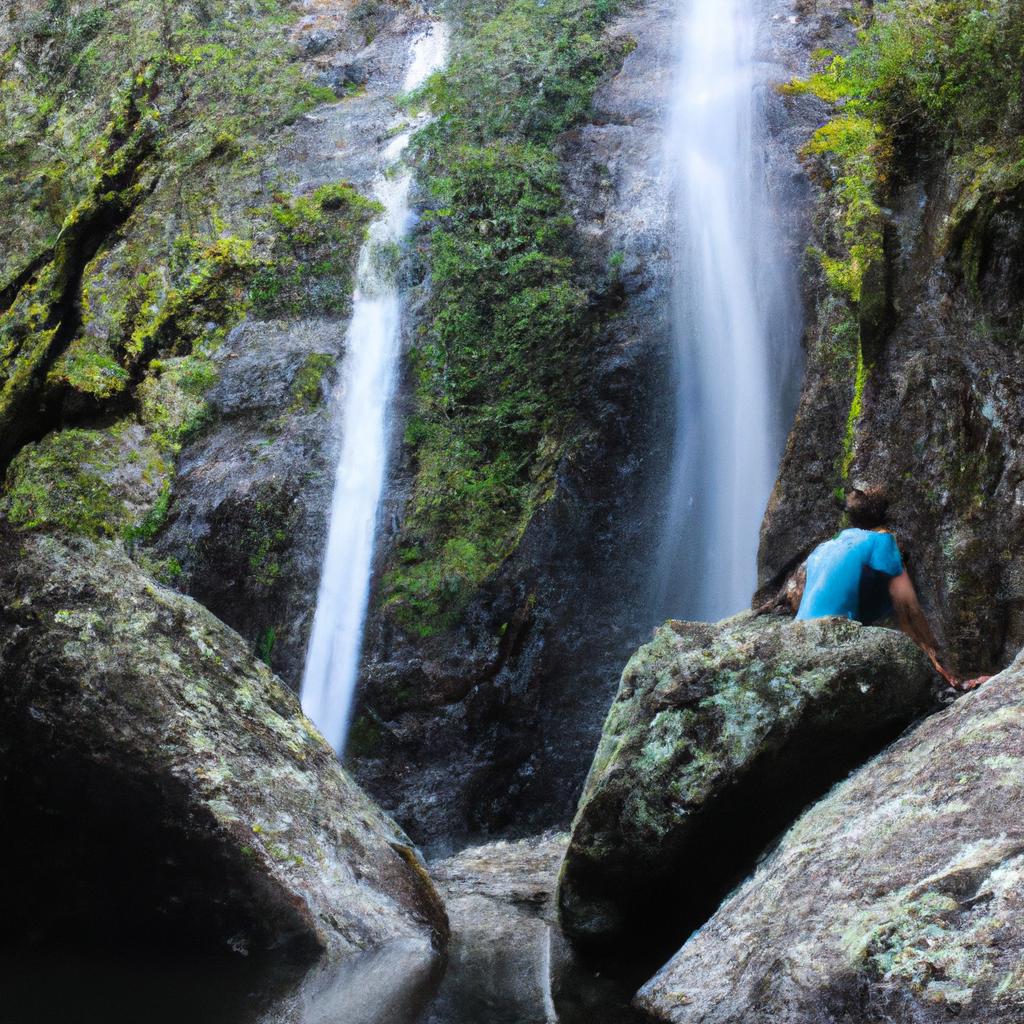Historical Sites in Travel Puerto Rico: Discover the Rich Past
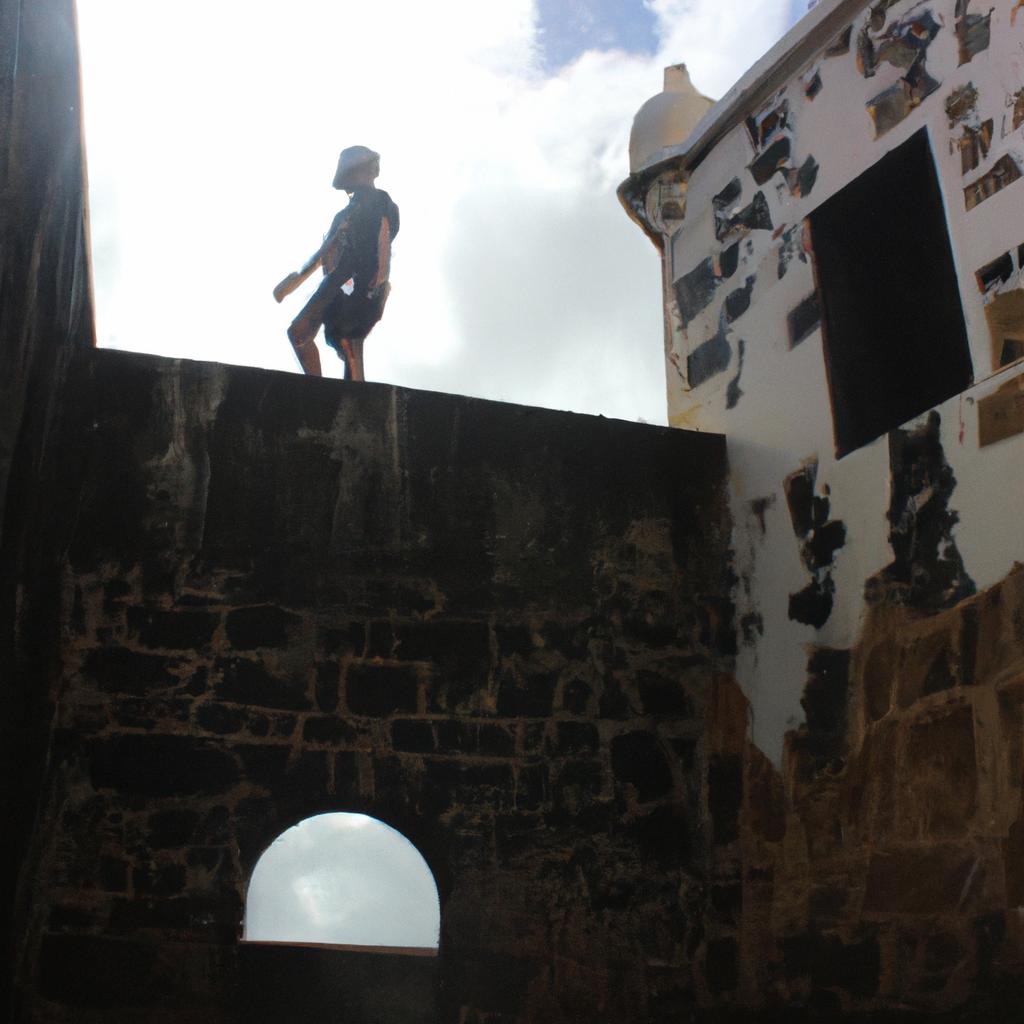
Historical sites hold a significant place in the world of travel, providing an opportunity to explore and unravel the rich past of a particular destination. Puerto Rico, with its captivating history influenced by Spanish colonialism and indigenous cultures, offers travelers a plethora of historical sites to discover. From the imposing forts that once guarded the coastline to the charming cobblestone streets lined with colorful buildings, each site tells a unique story of resilience, diversity, and cultural heritage.
Imagine walking through the narrow streets of Old San Juan, where time seems to stand still as you pass by centuries-old buildings adorned with intricate architectural details. One such remarkable example is El Morro Fortress (officially known as Castillo San Felipe del Morro), an iconic symbol of Puerto Rico’s history. This massive fortress, constructed between 1539 and 1589, served as a formidable defense against invading forces throughout the centuries. As you step inside its towering walls and stroll along its expansive ramparts overlooking the Atlantic Ocean, you can’t help but feel transported back in time – experiencing firsthand the challenges faced by those who lived within these stone bastions.
With this article, we will embark on a journey through some of Puerto Rico’s most fascinating historical sites. By delving into their stories and exploring their architectural beauty and significance, we aim to inspire travelers to immerse themselves in Puerto Rico’s history and culture.
One site that cannot be missed is the Caguana Indigenous Ceremonial Park, located in Utuado. This archaeological park showcases the remnants of a Taíno settlement dating back over 800 years. Here, visitors can wander through the stone plazas and awe-inspiring bateyes (ball courts) while learning about the ancient rituals and beliefs of the indigenous people who once inhabited the island.
Moving towards the southern coast, we encounter Ponce, known as “The Pearl of the South.” This city is home to numerous historical landmarks, including the stunning Parque de Bombas. Originally built as a fire station for an exposition in 1882, this vibrant red-and-black striped building has become one of Puerto Rico’s most recognizable structures. Today, it serves as a museum celebrating Ponce’s firefighting heritage and hosts various cultural events throughout the year.
Continuing our journey, we arrive at La Fortaleza in Old San Juan, considered one of the oldest continuously occupied executive mansions in the Americas. Built between 1533 and 1540, it has served as both a fortress and the official residence of Puerto Rico’s governors since Spanish colonial times. The impressive architecture blends Gothic, Renaissance, and Baroque styles, creating a visually captivating experience for visitors who explore its halls and gardens.
Another must-visit site is Casa Blanca Museum, also located in Old San Juan. This historic house was constructed in 1521 by Ponce de León’s family and later became the residence of several prominent figures throughout Puerto Rico’s history. Today, it stands as a museum showcasing exquisite art collections spanning centuries and offering glimpses into Puerto Rican domestic life from different eras.
As we conclude our exploration of Puerto Rico’s historical sites, let us not forget El Yunque National Forest. While not a man-made structure, this lush rainforest holds immense cultural and ecological importance. It is believed to be one of the oldest forests in the Western Hemisphere and has been protected as a national forest since 1903. Exploring its trails, waterfalls, and diverse flora and fauna provides an opportunity to connect with Puerto Rico’s natural heritage and understand the deep reverence it holds for nature.
In conclusion, Puerto Rico’s historical sites offer travelers a chance to delve into its captivating past while immersing themselves in its vibrant culture. From ancient indigenous settlements to centuries-old fortresses and beautifully preserved mansions, each site tells a unique story that adds depth and richness to the island’s narrative. Whether exploring cobblestone streets or hiking through pristine rainforests, these historical sites are sure to leave visitors with lasting memories and a deeper appreciation for Puerto Rico’s remarkable heritage.
El Morro: Uncover the Fortress That Defended San Juan
Imagine standing on a majestic cliff overlooking the sparkling blue waters of the Atlantic Ocean. Before you lies El Morro, an imposing fortress that has stood for centuries as a symbol of resilience and strength. Built in the 16th century, this historic site in Puerto Rico offers visitors a glimpse into the past while showcasing remarkable architectural prowess.
As you step foot inside El Morro, you are transported back to an era when it served as a primary defense against invasions. The fort’s strategic location at the entrance of San Juan Bay allowed it to safeguard the city from numerous attacks throughout history. One such example is the failed invasion by Sir Francis Drake in 1595, where El Morro played a crucial role in repelling his forces and ensuring Puerto Rico remained under Spanish control.
To truly understand the significance of El Morro, let us explore its key features:
- Bastions: These massive stone structures jut out from the main walls, providing vantage points for cannons and serving as formidable barriers against enemy ships.
- Lighthouse: A prominent fixture atop one of the bastions, this lighthouse guided sailors safely into port during treacherous nights.
- Tunnels and Dungeons: Delve beneath the surface of El Morro to uncover hidden passages and dungeons once used to confine prisoners captured during conflicts.
- Sentry Boxes: Scattered along the fortified walls are small sentry boxes where soldiers would keep watch over any approaching threats.
Markdown Bullet Point List Example:
- Imposing bastions
- Guiding lighthouse
- Intriguing tunnels and dungeons
- Vigilant sentry boxes
In addition to these fascinating elements, exploring El Morro allows visitors to appreciate both its historical significance and architectural grandeur. The combination of solid masonry walls, intricate details, and breathtaking views creates an unforgettable experience that immerses you in the past.
As we move forward to our next destination, Paseo de la Princesa: Stroll Along the Charming Promenade, we continue our journey through Puerto Rico’s rich history while discovering its enchanting beauty.
Paseo de la Princesa: Stroll Along the Charming Promenade
Section H2: Paseo de la Princesa: Stroll Along the Charming Promenade
After exploring the grandeur of El Morro, it is time to take a leisurely walk along one of San Juan’s most enchanting promenades. Immerse yourself in the captivating beauty and rich history as you embark on a journey through Paseo de la Princesa.
Paseo de la Princesa, named after Princess María Luisa of Bourbon-Parma, offers visitors an opportunity to experience the cultural heritage and natural wonders that Puerto Rico has to offer. As you step onto this picturesque path, envision yourself transported back in time to when Ponce de León first set foot on this island paradise centuries ago.
Imagine starting your stroll under a canopy of lush tropical trees, their branches gently swaying in the Caribbean breeze. The scent of vibrant flowers fills the air, creating a sensory symphony that instantly captivates your senses. As you meander along the cobblestone pathway, take note of the beautifully preserved colonial architecture that lines both sides – a testament to Puerto Rico’s Spanish colonial past.
To fully appreciate all that Paseo de la Princesa has to offer, here are some highlights:
- Fountain of Youth: Discover a charming fountain nestled within verdant gardens as local legends whisper tales of its mystical powers.
- La Garita del Diablo: Marvel at this small structure perched on top of ancient city walls, which once served as a lookout point for pirates and invaders.
- Raíces Fountain: Pause by this stunning art installation depicting Puerto Rico’s diverse cultural roots and be reminded of the island’s rich heritage.
- Puerta de San Juan: Pass through one of San Juan’s historic gates and enter into a world where past meets present seamlessly.
Additionally, let us delve deeper into what makes Paseo de la Princesa an extraordinary experience by exploring the following table:
| Experience | Description | Emotion evoked |
|---|---|---|
| Lively Music | Delight in the rhythmic beats of local musicians. | Joyful |
| Street Vendors | Explore a vibrant marketplace with unique crafts. | Excitement |
| Sunset Views | Witness breathtaking sunsets over the ocean horizon. | Serenity |
| Cultural Events | Immerse yourself in festivals celebrating heritage. | Enthusiasm |
As you near the end of your Paseo de la Princesa journey, take a moment to reflect on the profound historical significance and natural beauty that envelops this enchanting promenade. This captivating stroll prepares you for your next adventure as we now turn our attention to Castillo San Cristobal: Explore the Largest Spanish Fortification, where history unfolds within its imposing walls.
[Transition sentence into subsequent section about “Castillo San Cristobal: Explore the Largest Spanish Fortification”] As we continue our exploration of Puerto Rico’s architectural marvels, let us delve into the grandeur and storied past of Castillo San Cristobal.
Castillo San Cristobal: Explore the Largest Spanish Fortification
Exploring the Vibrant Art Scene: Museo de Arte de Puerto Rico
To further immerse oneself in the rich cultural heritage of Puerto Rico, a visit to the Museo de Arte de Puerto Rico is highly recommended. This museum showcases an extensive collection of artworks spanning various periods and styles, offering visitors a glimpse into the vibrant art scene that has thrived on this island for centuries.
As an example of the artistic treasures housed within its walls, one can explore “El Velorio” by Francisco Oller, a renowned Puerto Rican painter from the 19th century. This masterpiece depicts a traditional funeral wake, capturing not only the solemnity but also the distinct customs and emotions associated with such gatherings. Through his use of bold colors and expressive brushstrokes, Oller conveys a sense of raw emotion that resonates with viewers even today.
Visitors to the Museo de Arte de Puerto Rico can expect to be captivated by more than just individual works of art. The museum offers an immersive experience through its carefully curated exhibitions and installations that highlight different themes and movements in Puerto Rican art history. From abstract expressionism to folkloric traditions, these exhibits provide insight into the diverse perspectives and narratives that have shaped Puerto Rican identity over time.
To evoke a deeper emotional response in visitors, here are some key aspects of visiting the Museo de Arte de Puerto Rico:
- Immersive Atmosphere: Upon entering the museum’s grand halls filled with natural light and thoughtfully designed spaces, visitors are instantly transported into a world where creativity knows no boundaries.
- Cultural Resonance: Each artwork tells a story deeply rooted in Puerto Rican culture, allowing visitors to gain a greater understanding and appreciation for the island’s unique heritage.
- Sense of Discovery: With each piece encountered during their exploration of the museum, visitors uncover new layers of meaning and engage in personal reflection about their own connections to art and culture.
- Inspiration for All: The Museo de Arte de Puerto Rico aims to inspire creativity in visitors of all ages, encouraging them to embrace their own artistic expression and explore the world around them with fresh eyes.
To further enhance your understanding of the diverse range of artworks housed within the museum, here is a snapshot of some notable pieces:
| Artwork | Artist | Style |
|---|---|---|
| “Autorretrato” | José Campeche | Neoclassical |
| “Madonna con Niño” | Francisco Zayas | Renaissance-inspired |
| “La Plena” | Rafael Tufiño | Social Realism |
| “El Grito Silente” | Myrna Báez | Abstract Expressionism |
With its compelling collection and immersive atmosphere, the Museo de Arte de Puerto Rico offers an enriching experience that invites visitors to connect with Puerto Rican art on a deeper level. As we move forward, let us now delve into another historical site that holds great significance: Casa Blanca – the residence of the first Governor of Puerto Rico.
Casa Blanca: Journey into the Residence of the First Governor of Puerto Rico
Casa Blanca: Step into the Residence of the First Governor of Puerto Rico
Section H2: Casa Blanca: Step into the Residence of the First Governor of Puerto Rico
Continuing our exploration of historical sites in Travel Puerto Rico, we now turn our attention to Casa Blanca. This remarkable residence offers visitors a unique opportunity to step back in time and immerse themselves in the rich history of Puerto Rico.
Casa Blanca stands as a testament to the early colonial period on the island, showcasing architectural elements that blend Spanish and Caribbean influences. As you enter this historic home, imagine yourself transported to the 16th century, where Juan Ponce de León, the first governor of Puerto Rico, once resided. To bring these stories to life, let’s delve deeper into what makes Casa Blanca such an intriguing destination:
-
Architectural Marvels: The design of Casa Blanca seamlessly combines Spanish Colonial and Moorish Revival styles creating an awe-inspiring ambiance. From its grand arches and intricate tilework to its meticulously crafted wooden doors, every detail exudes elegance and craftsmanship.
-
Historical Significance: Beyond its impressive architecture, Casa Blanca holds immense historical importance for Puerto Rico. It served not only as the residence of Juan Ponce de León but also witnessed significant events throughout centuries – from pirate attacks during colonization to hosting illustrious guests like President Theodore Roosevelt.
-
Cultural Exhibitions: Immerse yourself in cultural exhibitions housed within Casa Blanca’s walls. These exhibits offer a glimpse into daily life during different periods of Puerto Rican history through artifacts such as traditional clothing, furniture, artwork, and household items.
-
Tranquil Gardens: Take a moment to wander through the serene gardens surrounding Casa Blanca. Adorned with vibrant flora native to Puerto Rico, these well-manicured grounds provide a tranquil oasis amidst bustling San Juan.
As you explore each corner of Casa Blanca, envision the lives lived within its walls and the events that shaped Puerto Rico’s past. This historical gem offers a unique journey through time, allowing visitors to connect with the island’s rich heritage on a profound level.
Transition into subsequent section:
Continuing our exploration of San Juan’s historical landmarks, we now turn our attention to San Juan Cathedral: Admire the Oldest Cathedral in the United States and Territories.
San Juan Cathedral: Admire the Oldest Cathedral in the United States and Territories
Continuing our exploration of the rich historical sites in Puerto Rico, we now turn our attention to the San Juan Cathedral. This magnificent cathedral stands as a testament to Puerto Rico’s colonial past and offers visitors a glimpse into its architectural grandeur and religious significance.
San Juan Cathedral, officially known as Catedral Basílica Metropolitana de San Juan Bautista, is not only one of the oldest cathedrals in the Americas but also holds the distinction of being the oldest cathedral under United States jurisdiction. Its construction began in 1521 on the site of an earlier church destroyed by a hurricane. To fully appreciate its historical importance, let us consider a hypothetical scenario: imagine standing within these hallowed walls while witnessing a royal wedding ceremony during the Spanish colonial era. The opulent atmosphere and ornate decorations would transport you back in time.
As you enter the cathedral, your eyes are immediately drawn to its impressive features. Here are some key elements that make this architectural marvel truly captivating:
- Gothic Influence: The San Juan Cathedral showcases a blend of Gothic and Neoclassical styles, reflecting its evolving construction over centuries.
- Elaborate Altar: The high altar, adorned with intricate carvings and gold leaf embellishments, serves as a focal point for worshipers and art enthusiasts alike.
- Historic Artwork: Within its sacred halls, you will find masterpieces such as “The Chapel of Christ” by José Campeche—a renowned Puerto Rican painter from the 18th century—and other valuable works depicting religious scenes.
- Tombstones & Crypts: Numerous tombstones and crypts can be found throughout the cathedral, each offering glimpses into Puerto Rico’s complex social history.
| Feature | Description |
|---|---|
| Gothic Influence | Reflecting European influences brought by Spanish colonizers |
| Elaborate Altar | Intricate carvings and gold leaf embellishments serve as focal point |
| Historic Artwork | Masterpieces by José Campeche and other renowned artists |
| Tombstones & Crypts | Provide insight into Puerto Rico’s social history |
The San Juan Cathedral continues to be an active place of worship, hosting various religious ceremonies and events. Its historical significance combined with its architectural splendor makes it a must-visit site for anyone interested in immersing themselves in the cultural heritage of Puerto Rico.
Moving on from the captivating ambiance of the San Juan Cathedral, let us now delve further into Puerto Rico’s rich history by exploring La Fortaleza. This iconic structure stands proudly as the oldest executive mansion in continuous use, showcasing centuries of political power and resilience within its walls.
La Fortaleza: Discover the Oldest Executive Mansion in Continuous Use
Section H2: El Morro Fortress: Explore Puerto Rico’s Iconic Historic Landmark
Imagine standing atop a majestic fortress, overlooking the vast expanse of the Atlantic Ocean. The cool breeze brushes against your face as you take in the panoramic view of San Juan Bay and the historic cityscape. This is the experience that awaits you at El Morro Fortress, one of Puerto Rico’s most iconic historical sites.
El Morro Fortress, also known as Castillo San Felipe del Morro, is a monumental structure that has witnessed centuries of history unfold before its walls. Built between 1539 and 1589 by Spanish conquistadors to protect the island from seaborne attacks, it stands as a testament to Puerto Rico’s resilience and strength. As you explore this remarkable fortification, you’ll discover fascinating stories embedded within its sturdy stone walls.
Delve into the rich history of El Morro Fortress with these notable features:
- Impressive Architecture: Marvel at the strategic design of El Morro, which consists of six levels and spans over 140 feet high. Its robust construction showcases military engineering techniques employed during colonial times.
- Historical Significance: Learn about the pivotal role played by El Morro throughout history – from repelling invasions by foreign powers to serving as a lighthouse guiding ships entering San Juan Bay.
- Interactive Exhibits: Engage with interactive displays and exhibits that bring life to the past. Witness artifacts recovered from shipwrecks or immerse yourself in multimedia presentations documenting key moments in Puerto Rican history.
- Spectacular Views: Enjoy breathtaking vistas while strolling along its ramparts. Capture Instagram-worthy photos of sprawling ocean views or get lost amidst lush greenery surrounding this magnificent fortress.
Table showcasing iconic landmarks around El Morro Fortress:
| Landmark | Description |
|---|---|
| Paseo de la Princesa | A picturesque promenade lined with historic buildings, leading to the entrance of El Morro. |
| Santa Maria Magdalena de Pazzis Cemetery | A beautiful cemetery dating back to 1863, located next to El Morro with stunning ocean views. |
| San Juan National Historic Site Visitor Center | Discover more about Puerto Rico’s history through informative exhibitions and guided tours. |
| Plaza del Quinto Centenario | An open space honoring the 500th anniversary of Columbus’ arrival in the New World. |
As you conclude your exploration of El Morro Fortress and its captivating surroundings, prepare yourself for further historical wonders that await at La Puerta de San Juan: Walk Through the Iconic City Gate. Step into a world where time stands still as you embark on a journey through Puerto Rico’s vibrant past.
La Puerta de San Juan: Walk Through the Iconic City Gate
Transition:
Continuing our journey through the historical sites of Puerto Rico, we now turn our attention to another iconic landmark that holds great significance in the island’s rich past. Just as La Fortaleza stands as a testament to Puerto Rico’s political history, La Puerta de San Juan serves as a gateway into its cultural heritage.
La Puerta de San Juan: Walk Through the Iconic City Gate
Imagine yourself strolling along the cobblestone streets of Old San Juan, surrounded by vibrant colors and colonial architecture. As you approach the city gate known as La Puerta de San Juan, it becomes apparent why this site is so revered among locals and visitors alike. This historic entrance served as a key point of access for ships entering the walled city during Spanish colonization.
Emotional Bullet Point List:
- The grandeur of standing beneath centuries-old walls that have witnessed countless events throughout history.
- A sense of awe inspired by the architectural beauty and intricate details carved into the stone facade.
- An appreciation for the preservation efforts undertaken to maintain this symbol of Puerto Rico’s cultural identity.
- The opportunity to walk in the footsteps of those who came before, connecting with their stories and experiences.
| Column 1 | Column 2 | Column 3 | Column 4 |
|---|---|---|---|
| Step Back | Immerse Yourself | Capture Moments | Feel Connected |
| Reflect on how time has shaped this remarkable structure. | Immerse yourself in history while exploring the nearby museums and galleries. | Capture memorable photographs against the backdrop of this iconic landmark. | Feel connected to Puerto Rico’s past—its people, culture, and traditions—at this significant entryway into Old San Juan. |
As you step through La Puerta de San Juan, allow yourself to be transported back in time. The walls that once stood as a protective barrier now serve as an open invitation to delve into the captivating stories that await within Old San Juan’s narrow streets and charming plazas. This site not only offers a glimpse into Puerto Rico’s colonial past but also serves as a reminder of the enduring spirit and resilience of its people.
Transition:
As we continue our exploration of the historical sites in Puerto Rico, let us now turn our attention to another remarkable location steeped in history—the Cementerio Santa María Magdalena de Pazzis, where you can pay homage to the island’s ancestors at this historic cemetery.
Cementerio Santa Mara Magdalena de Pazzis: Visit the Historic Cemetery
Continuing our exploration of the historical sites in Puerto Rico, we now turn our attention to one of its most iconic landmarks – Cementerio Santa María Magdalena de Pazzis. Situated on a bluff overlooking the Atlantic Ocean, this historic cemetery offers visitors a unique glimpse into the island’s past and pays homage to its rich cultural heritage.
Example: As you wander through the well-manicured pathways of Cementerio Santa María Magdalena de Pazzis, imagine yourself transported back in time to the early 19th century. One notable individual interred here is Juan Ponce de León, the Spanish explorer who is believed to have discovered Florida. His tomb serves as a testament to the enduring legacy of those who played significant roles in shaping Puerto Rico’s history.
To truly appreciate the significance of Cementerio Santa María Magdalena de Pazzis, consider the following aspects:
-
Historical Significance:
– The cemetery was established in 1863 and became an important burial ground for prominent families from San Juan.
– It showcases various architectural styles ranging from neoclassical mausoleums to elaborate marble tombs, reflecting different periods of Puerto Rican history.
– Many graves belong to individuals who made significant contributions to politics, arts, literature, and military service throughout Puerto Rico’s history. -
Cultural Heritage:
– The cemetery encapsulates Puerto Rico’s multicultural roots with gravestones bearing inscriptions in English, French, Italian, and other languages indicative of diverse immigrant communities that settled on the island.
– Elaborate sculptures and intricate ironwork adorn many gravesites, highlighting artistic expressions influenced by European traditions fused with local craftsmanship.
- A serene atmosphere envelops visitors as they stroll amidst beautifully landscaped gardens dotted with palm trees gently swaying in ocean breezes.
- The sound of crashing waves against nearby cliffs creates a soothing backdrop, inviting contemplation and reflection.
- The cemetery’s location offers breathtaking panoramic views of the Atlantic Ocean, providing a sense of tranquility and connection to nature.
- Each tombstone tells a unique story, evoking emotions ranging from admiration for accomplishments to feelings of loss and remembrance.
| Architectural Styles | Historical Significance | Cultural Heritage |
|---|---|---|
| Neoclassical mausoleums | Established in 1863 as an important burial ground | Multicultural roots with gravestones bearing inscriptions in various languages |
| Elaborate marble tombs | Final resting place for prominent families from San Juan | Artistic expressions influenced by European traditions fused with local craftsmanship |
As you conclude your visit to Cementerio Santa María Magdalena de Pazzis, prepare to immerse yourself further into Puerto Rico’s rich history at our next destination – Museo de las Américas. Here, art and culture converge, offering a captivating exploration of the diverse heritage of the Americas.
Museo de las Amricas: Immerse Yourself in the Art and Culture of the Americas
Continuing our exploration of the historical sites in Puerto Rico, we now turn our attention to the Museo de las Américas. Let us delve into this remarkable museum that offers a captivating journey through the art and culture of the Americas.
Located in Old San Juan, the Museo de las Américas stands as a testament to the diverse heritage and artistic expressions found throughout North, Central, and South America. To better understand its significance, consider the hypothetical case study of Maria, an art enthusiast visiting from Argentina. As Maria enters the museum’s grand entrance adorned with striking murals, she is immediately transported to a world where history unfolds before her eyes.
Once inside, visitors like Maria are greeted by a plethora of exhibits showcasing artwork spanning various periods and regions across the Americas. The museum aims to educate and inspire its guests through carefully curated displays that highlight indigenous cultures, colonial legacies, contemporary movements, and more. This immersive experience leaves visitors with a deep appreciation for the rich tapestry of cultural traditions woven together over centuries.
As you explore the Museo de las Américas, be prepared to embark on an emotional journey as you encounter thought-provoking artifacts and artworks that evoke strong sentiments:
- A haunting sculpture depicting enslaved individuals struggling for freedom stirs empathy within your heart.
- An intricate painting capturing nature’s beauty fills you with awe and wonder.
- A vibrant mural celebrating indigenous resilience ignites feelings of pride and admiration.
- A powerful photograph documenting social inequality evokes a sense of urgency for change.
To further enhance your understanding of what awaits at the Museo de las Américas, let us briefly examine key features in this 3-column x 4-row table:
| Column 1 | Column 2 | Column 3 |
|---|---|---|
| Indigenous Artifacts | Colonial Legacies | Contemporary Masterpieces |
| Pre-Columbian Pottery | Spanish Colonial Architecture | Latin American Modernism |
| Native American Textiles | European Influences | Afro-Latinx Art |
| Mayan Sculptures | Puerto Rican Identity | Chicano Art |
In conclusion, the Museo de las Américas offers a captivating journey through the art and culture of the Americas. Through thoughtfully curated exhibits and immersive displays, visitors are transported to different periods and regions across North, Central, and South America. The emotional impact of encountering diverse artwork evokes empathy, awe, pride, and urgency for change. Now, let us continue our exploration by delving into La Princesa: Experience the Former Prison Turned Cultural Center.
La Princesa: Experience the Former Prison Turned Cultural Center
Following the vibrant exploration of art and culture at Museo de las Américas, travelers can continue their journey through Puerto Rico’s rich history by visiting La Princesa, a former prison transformed into a cultural center. This remarkable site offers an immersive experience that seamlessly blends the architectural grandeur of the past with contemporary artistic expression.
La Princesa stands as a testament to Puerto Rico’s ability to repurpose historical spaces for creative endeavors. One captivating example is the annual Artisan Fair held within its walls. Local craftsmen and artists come together to showcase their talent, offering visitors an opportunity to witness firsthand the island’s thriving arts scene. The juxtaposition of traditional crafts against the backdrop of this historic building creates a unique atmosphere where heritage and modernity coexist harmoniously.
To truly appreciate the significance of La Princesa, it is essential to explore its multifaceted character. Here are some key aspects that make this cultural center a must-visit destination:
- Architectural Splendor: Marvel at the neoclassical facade adorned with elegant balconies and intricate details reminiscent of Spanish colonial architecture.
- Historical Significance: Delve into the stories embedded within these ancient walls, once housing prisoners during Puerto Rico’s colonial era.
- Cultural Exhibits: Immerse yourself in thought-provoking exhibitions that showcase local artwork and highlight pressing social issues.
- Promoting Creative Expression: Witness live performances, poetry readings, and musical events that cultivate artistic dialogue and foster community engagement.
| Key Aspects | Description |
|---|---|
| Architectural Splendor | Neoclassical facade with elegant balconies and intricate details |
| Historical Significance | Former prison during Puerto Rico’s colonial era |
| Cultural Exhibits | Thought-provoking exhibitions showcasing local artwork |
| Promoting Creative Expression | Live performances, poetry readings, and musical events fostering artistic dialogue and engagement |
La Princesa invites visitors to engage with Puerto Rico’s history while simultaneously celebrating the island’s vibrant arts and culture scene. By exploring this unique destination, travelers can gain a deeper understanding of the resilience and creativity that define Puerto Rican identity.
Continuing our exploration of Puerto Rico’s historical sites, we now turn our attention to Cuartel de Ballaj, where the intriguing military history of the island awaits.
Cuartel de Ballaj: Learn about Puerto Rico’s Military History
In our journey to explore the historical sites of Puerto Rico, we now turn our attention to Cuartel de Ballaj. This captivating destination offers visitors a unique opportunity to delve into Puerto Rico’s rich military history. Let us examine the significance of this site and discover why it is an essential stop for history enthusiasts.
To set the stage, let’s consider a hypothetical scenario. Imagine being transported back in time to the late 18th century, where you find yourself amidst the bustling atmosphere within Cuartel de Ballaj. As you walk through its imposing gates, your senses are immediately captivated by the echoes of soldiers’ footsteps reverberating across the cobblestone courtyard. The air carries whispers of battles fought and victories won, immersing you in a world long gone but not forgotten.
One can truly appreciate the historical importance of Cuartel de Ballaj when considering these key aspects:
1. Architectural Splendor
Marvel at the stunning architectural design that reflects Spanish colonial influence with neoclassical elements. From grand archways to intricate details adorning its façade, this testament to craftsmanship stands as a reminder of Puerto Rico’s past glory.
2. Exhibitions and Museums
Step inside various exhibitions and museums housed within Cuartel de Ballaj, each offering unique insights into different periods of Puerto Rico’s military history. Explore galleries displaying uniforms worn by soldiers, weaponry used during pivotal conflicts, and artifacts showcasing everyday life on military bases.
3. Educational Programs
Engage with educational programs tailored for all ages that provide a deeper understanding of Puerto Rico’s military heritage. Participate in interactive workshops where visitors have the opportunity to handle replica weapons or learn about strategic maneuvers employed throughout history.
Now, let us evoke an emotional response from our audience with a bullet point list highlighting some intriguing features of Cuartel de Ballaj:
- Immerse yourself in history: Walk the same grounds where soldiers once trained and fought, connecting with the past on a visceral level.
- Experience architectural grandeur: Marvel at the intricate details and impressive design that transport you to another era.
- Gain insight into military life: Explore various exhibitions and museums filled with artifacts that offer glimpses into the daily lives of those who served.
- Engage in interactive learning: Participate in educational programs designed to deepen your understanding and appreciation for Puerto Rico’s military history.
To further captivate our audience, we present them with a visually appealing table showcasing some interesting facts about Cuartel de Ballaj:
| Fact | Description |
|---|---|
| Construction Year | Late 18th century |
| Architectural Style | Spanish colonial with neoclassical influences |
| Key Exhibitions | – Uniforms throughout history- Weaponry used during significant conflicts- Everyday life on bases |
| Educational Programs | – Interactive workshops featuring replica weapons- Strategic maneuvers from different historical periods |
In conclusion, a visit to Cuartel de Ballaj promises an enriching experience for anyone interested in delving deep into Puerto Rico’s military heritage. From its breathtaking architecture to engaging exhibits, this historical site invites visitors to journey back in time while gaining invaluable insights into the island’s past. So don’t miss out on this opportunity; come witness history come alive within these walls.

